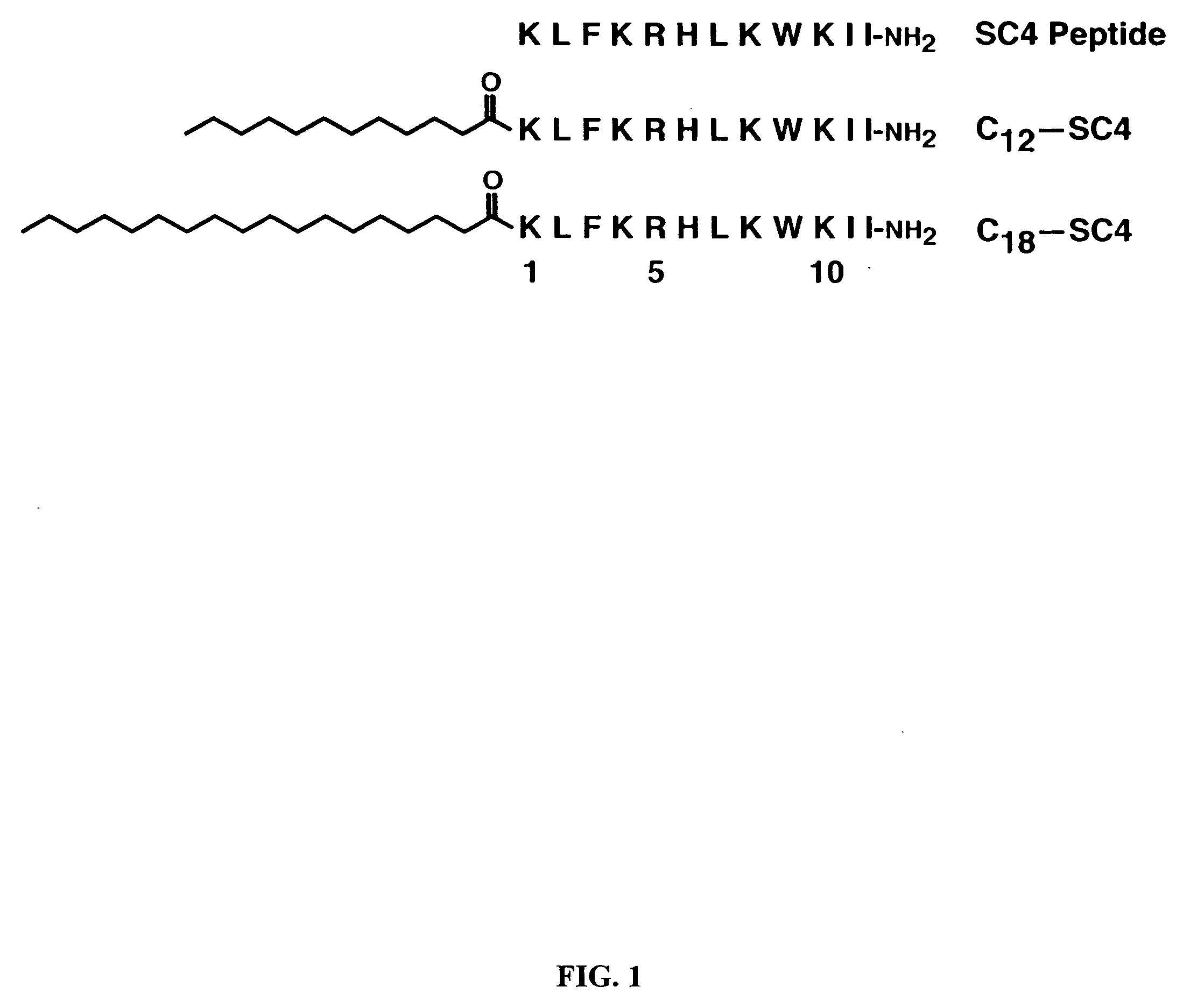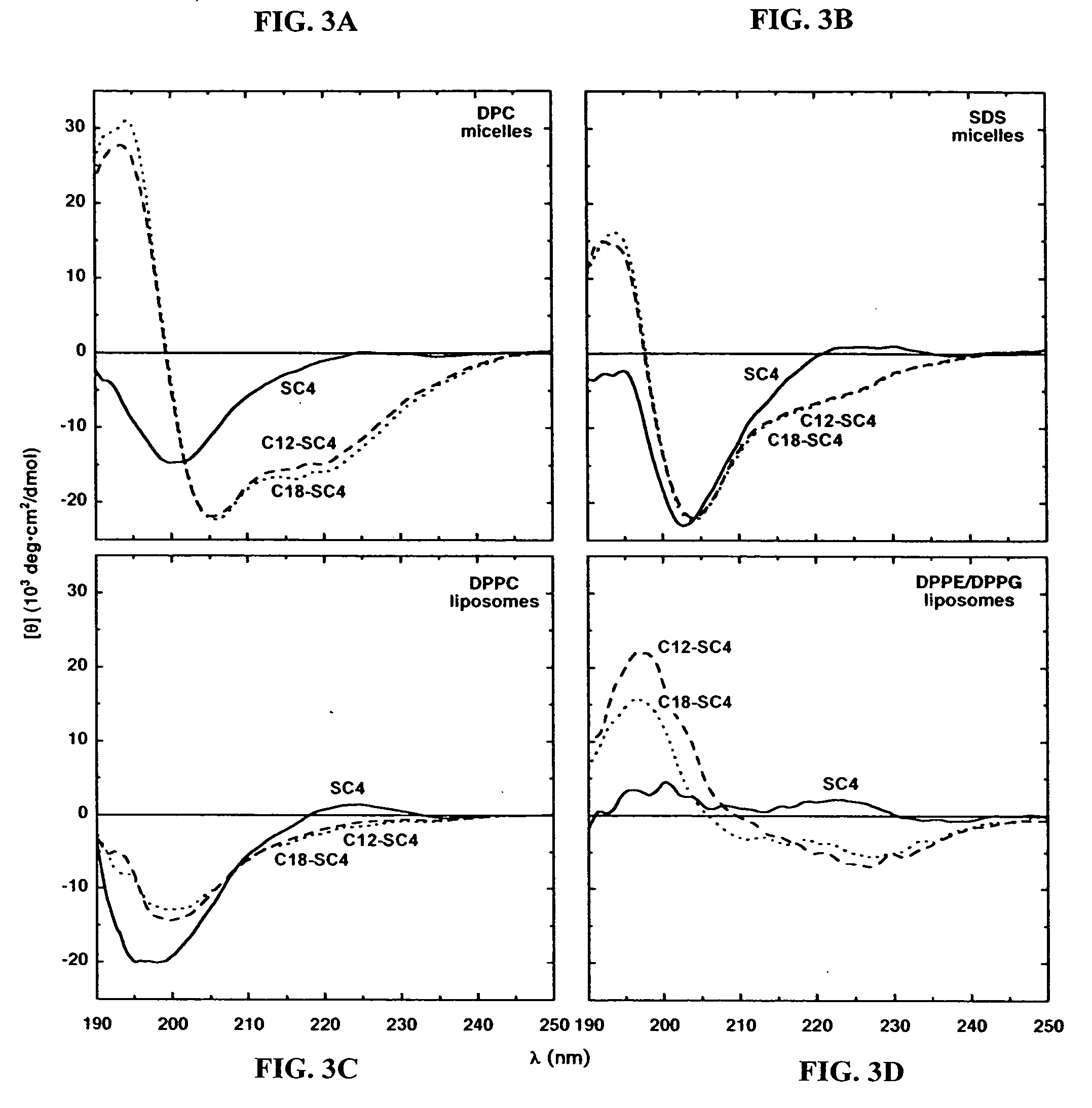Modified polypeptides with therapeutic activity and methods of use
- Summary
- Abstract
- Description
- Claims
- Application Information
AI Technical Summary
Benefits of technology
Problems solved by technology
Method used
Image
Examples
example 1
Actylation of SC4 Dodecapeptide Increases Bactericidal Potency Against Gram-Positive and Drug-Resistant Bacteria
[0104] Dodecyl and octadecyl fatty acids were conjugated to the N-terminus of SC4, a potently bactericidal, helix-forming peptide 12-mer with the amino acid sequence KLFKRHLKWKII (SEQ ID NO:4) and the bactericidal activities of the resultant SC4 “peptide-amphiphile” molecules examined. SC4 peptide-amphiphiles showed up to a thirty fold increase in bactericidal activity against Gram-positive strains S. aureus, S. pyogenes, and B. anthracis, including S. aureus strains resistant to conventional antibiotics, but little or no increase against the Gram-negative bacteria E. coli and P. aeruginosa. Fatty acid conjugation improved endotoxin (lipopolysaccharide) neutralization three to six fold. Although acylation somewhat increased lysis of human erythrocytes, it did not increase lysis of endothelial cells, and the hemolytic effects occurred at concentrations 10- to 100-fold high...
example 2
N-Terminal Acylation Improves Antibacterial Activity
[0145] Following procedures outlined in Example 1, the antibacterial effect of the SC-4 peptide and the C12-SC4 and C18-SC4 N-terminal acylation of SC4 on five different Gram-positive bacterial strains was determined. The bacterial strains used were MN8, Hoch, Knutson, FR1722, and RN6390 (Lockwood et al., Biochem. J. 378, 93-103 (2004). Dose response results are shown in FIG. 10 to FIG. 14, respectively.
[0146] These results further demonstrate that N-terminal acylation (C12 and C18) of SC4 greatly improves the anti-bacterial activity of the SC-4 peptide. This antibacterial effect tends to be specific for Gram-positive bacteria, including staph and anthrax strains. Activity against Gram-negative strains is increased by only about two-fold at best. This is consistent with known differences in these bacterial membranes through which SC-4 and this entire class of new antibacterial agents works.
[0147] For the C18 derivative, ten to t...
example 3
Promotion of Peptide Antimicrobial Activity by Fatty Acid Conjugation
[0150] Three peptides, YGAA[KKAAKAA](2) (SEQ ID NO:20), also referred to as “AKK,” KLFKRHLKWKII (SC4), and YG[AKAKAAKA](2) (SEQ ID NO:2 1), also referred to as “KAK,” were conjugated with lauric acid and tested for the effect on their structure, antibacterial activity, and eukaryotic cell toxicity (Chu-Kung et al., Bioconjug Chem. 15(3):530-5 (2004). The conjugated AKK and SC4 peptides showed increased antimicrobial activity relative to unconjugated peptides, but the conjugated KAK peptide did not. The circular dichroism spectrum of AKK showed a significantly larger increase in its alpha-helical content in the conjugated form than peptide KAK in a solution containing phosphatidylethanolamine / phosphotidylglycerol vesicles, which mimics bacterial membranes. The KAK and AKK peptides and their corresponding fatty acid conjugates showed little change in their structure in the presence of phosphatidylcholine vesicles, w...
PUM
| Property | Measurement | Unit |
|---|---|---|
| Acidity | aaaaa | aaaaa |
| Pharmaceutically acceptable | aaaaa | aaaaa |
| Cell proliferation rate | aaaaa | aaaaa |
Abstract
Description
Claims
Application Information
 Login to View More
Login to View More - R&D
- Intellectual Property
- Life Sciences
- Materials
- Tech Scout
- Unparalleled Data Quality
- Higher Quality Content
- 60% Fewer Hallucinations
Browse by: Latest US Patents, China's latest patents, Technical Efficacy Thesaurus, Application Domain, Technology Topic, Popular Technical Reports.
© 2025 PatSnap. All rights reserved.Legal|Privacy policy|Modern Slavery Act Transparency Statement|Sitemap|About US| Contact US: help@patsnap.com



